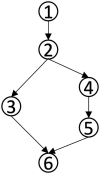Cognitive model construction and assessment of data analysis ability based on CDA
- PMID: 36457914
- PMCID: PMC9706193
- DOI: 10.3389/fpsyg.2022.1009142
Cognitive model construction and assessment of data analysis ability based on CDA
Abstract
Ability of data analysis, as one of the essential core qualities of modern citizens, has received widespread attention from the international education community. How to evaluate students' data analysis ability and obtain the detailed diagnosis information is one of the key issues for schools to improve education quality. With an employment of cognitive diagnostic assessment (CDA) as the basic theoretical framework, this study constructed the cognitive model of data analysis ability for 503 Grade 9 students in China. The follow-up analyses including the learning path, learning progression and corresponding personalized assessment were also provided. The result indicated that first, almost all the students had the data awareness. Furthermore, the probability of mastering the attribute Interpretation and inference of data was relatively low with only 60% or so. Also, the probabilities of mastering the rest of attributes were about 70% on average. It was expected that this study would provide a new cognitive diagnostic perspective on the assessment of students' essential data analysis abilities.
Keywords: ability assessment; cognitive diagnostic assessment; cognitive model; data analysis ability; math education.
Copyright © 2022 Wu, Zhang, Wu, Tang and Xu.
Conflict of interest statement
The authors declare that the research was conducted in the absence of any commercial or financial relationships that could be construed as a potential conflict of interest.
Figures
Similar articles
-
Cognitive analysis and path construction of Chinese students' mathematics cognitive process based on CDA.Sci Rep. 2025 Feb 5;15(1):4397. doi: 10.1038/s41598-025-89000-5. Sci Rep. 2025. PMID: 39910156 Free PMC article.
-
An International Comparative Study of Students' Scientific Explanation Based on Cognitive Diagnostic Assessment.Front Psychol. 2021 Dec 17;12:795497. doi: 10.3389/fpsyg.2021.795497. eCollection 2021. Front Psychol. 2021. PMID: 34975697 Free PMC article.
-
Validating a Reading Assessment Within the Cognitive Diagnostic Assessment Framework: Q-Matrix Construction and Model Comparisons for Different Primary Grades.Front Psychol. 2021 Dec 16;12:786612. doi: 10.3389/fpsyg.2021.786612. eCollection 2021. Front Psychol. 2021. PMID: 34975681 Free PMC article.
-
The effectiveness of school physical education on students' cognitive competence: a systematic review and meta-analysis.J Sports Med Phys Fitness. 2022 Apr;62(4):575-584. doi: 10.23736/S0022-4707.21.11796-7. J Sports Med Phys Fitness. 2022. PMID: 35350096
-
The academic environment: the students' perspective.Eur J Dent Educ. 2008 Feb;12 Suppl 1:120-30. doi: 10.1111/j.1600-0579.2007.00494.x. Eur J Dent Educ. 2008. PMID: 18289275 Review.
Cited by
-
Cognitive analysis and path construction of Chinese students' mathematics cognitive process based on CDA.Sci Rep. 2025 Feb 5;15(1):4397. doi: 10.1038/s41598-025-89000-5. Sci Rep. 2025. PMID: 39910156 Free PMC article.
References
-
- Arican M., Kuzu O. (2020). Diagnosing preservice teachers’ understanding of statistics and probability: developing a test for cognitive assessment. Int. J. Sci. Math. Educ. 18, 771–790. doi: 10.1007/s10763-019-09985-0 - DOI
-
- Batanero C., Díaz C. (2010). Training teachers to teach statistics: what can we learn from research? Statist. et enseignement 11, 83–20. doi: 10.1111/j.1467-9639.1989.tb00069.x - DOI
-
- Biggs J. B., Collis K. F. (2014). Evaluating the quality of learning: The SOLO taxonomy (structure of the observed learning outcome) Hobart, Tasmania, Austraila: Academic Press.
-
- Borges-Rey E. L. (2017). “Data literacy and citizenship: understanding ‘big Data'to boost teaching and learning in science and mathematics,” in Handbook of research on driving STEM learning with educational technologies. eds. M. S. Ramírez-Montoya (IGI Global), 65–79. doi: 10.4018/978-1-5225-2026-9.ch004 - DOI
-
- Bryant R., Katz R. H., Lazowska E. D. (2008). Big-data computing: creating revolutionary breakthroughs in commerce, science and society. Available at: https://cra.org/ccc/wp-content/uploads/sites/2/2015/05/Big_Data.pdf (Accessed October 20, 2022).
LinkOut - more resources
Full Text Sources





